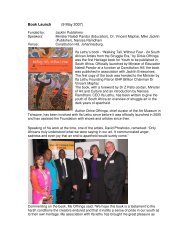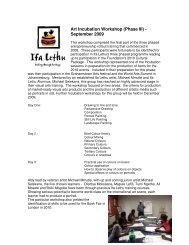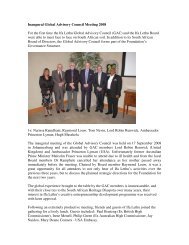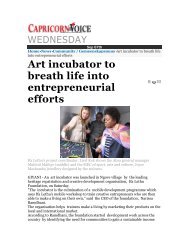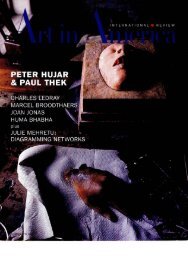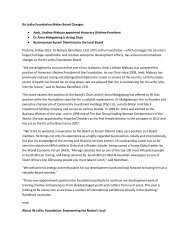archive_Mbombela Economic Summit Paper.pdf - Ifa Lethu
archive_Mbombela Economic Summit Paper.pdf - Ifa Lethu
archive_Mbombela Economic Summit Paper.pdf - Ifa Lethu
Create successful ePaper yourself
Turn your PDF publications into a flip-book with our unique Google optimized e-Paper software.
THE ROLE OF THE CREATIVE INDUSTRIES IN LOCAL ECONOMIC<br />
DEVELOPMENT: THE IFA LETHU FOUNDATION MODEL<br />
Speech by Dr Narissa Ramdhani, CEO<br />
<strong>Mbombela</strong> <strong>Summit</strong> on Local <strong>Economic</strong> Development. 26 January 2012.<br />
Ladies and Gentlemen<br />
I am most honoured to be here today in <strong>Mbombela</strong>. I am especially pleased to be in<br />
Mpumulanga as this province is one of our targets for <strong>Ifa</strong> <strong>Lethu</strong>’s Poverty Alleviation<br />
programme. For those of you who drove here today, you will have seen various<br />
craftspeople alongside many of our roads. They are men and women whose only source<br />
of income comes from the sale of products which are a result of their creative talents;<br />
Talents that have been passed from generation to generation and that preserve our<br />
people’s cultural heritage. But I will address this issue later. What I would like to do<br />
today in my address on the role of the creative industries in local economic development<br />
is to look at look at cultural heritage and the socio economic development of society and<br />
then proceed to examine how it has contributed to national economies and to<br />
Development at a Global level. This review would then allow me to examine cultural<br />
contribution to South Africa with reference to the model provided by the <strong>Ifa</strong> <strong>Lethu</strong><br />
Foundation of South Africa.<br />
During the UN Millennium <strong>Summit</strong> in 2000, 189 world leaders signed the Millennium<br />
Declaration, which committed the world to meeting the Millennium Development Goals<br />
by 2015. Ten years on, despite remarkable progress in some countries, the world seems to<br />
be falling short in the achievement of the MDGs. The consequences of this is that<br />
improvements in the lives of the poorest peoples of the world are happening at an<br />
unacceptably slow pace and in some countries, hard fought gains are being eroded. Some<br />
experts have predicted that at the current pace, several of the eight MDGs and associated<br />
targets are likely to be missed in many countries. The challenges have been seen to be most<br />
severe in the least developed countries (LDCs), land-locked developing countries (LLDCs)<br />
and some small island developing states (SIDS), many of which are found in Africa.<br />
According to the report of the MDG <strong>Summit</strong> of September 2010, if the 8 MDGs are to be<br />
fully achieved by 2015, not only must the level of financial investment be increased but<br />
innovative programmes and policies aimed at overall development and economic and<br />
social transformation must be rapidly scaled up and replicated.<br />
1
The <strong>Ifa</strong> <strong>Lethu</strong> Foundation, though its mandate and functions, has focused on how the<br />
continent and South Africa can use culture and heritage to assist the process of achieving<br />
the millennium development goals by 2015. I will speak more on this later. In essence<br />
then, the the Millennium Development Goals cannot be achieved without strong growth<br />
and it is the cultural sector, through creative entrepreneurship that may contribute to this<br />
growth through its potential in terms of employment linked to services, a particularly<br />
important sector for economies with little industrialization.<br />
My argument is strengthened by statistics provided by international literature such as<br />
European Affairs, Unicamp and the UK/India Business Counci. which indicate as follows:<br />
that in 2003, this sector contributed significantly to the GDP at the level of 3.2% in<br />
Norway, 3.0% in Great Britain and 2.3% in the Czech Republic 1 . The effect on<br />
employment was also significant. In Asia, the Indian cinematographic industry alone<br />
employs more than 4 million people and represents approximately 2.3 thousand million<br />
USD 2 . In Latin America, the copyright industries contributed 2% to the GDP of Chile and<br />
2.7% to its national employment between 1990 and 1998 3 . In Brazil, the cultural industries<br />
represented 6.7% of GDP and 5% of employment in 1986. Regarding France, Norway and<br />
Great Britain, a comparison with the figures for the agro-food industry reveals that the<br />
results of the cultural sector are higher. Therefore I would contend that in most countries,<br />
the cultural sector greatly contributes to their economic growth, especially since their<br />
growth indices are greater than GDP growth rates. It is therefore clearly apparent that this<br />
sector may constitute an engine of growth if States and other players establish institutional,<br />
legal and economic environments favourable to its development.<br />
CULTURAL CONTRIBUTION TO SOUTH AFRICA<br />
Now let us look at SA. There is no doubt that the cultural sector is a key economic driver in the<br />
country’s tourism industry. The Department of Trade and Industry estimates that South Africa's<br />
creative sector alone contributes about R2-billion or 0.14% to South Africa's GDP annually. In<br />
addition, the sector provides jobs and income for approximately 38 000 people through an<br />
estimated 7 000 small enterprises. But I believe we can do far better than this. The creative sector<br />
can also be used as a catalyst for rural economic development and for fostering expanded<br />
participation in the economy, especially by women and youth.Furthermore, as the art of designing<br />
and producing cultural products is handed down from generation to generation, members of<br />
communities have an opportunity to work together and impart knowledge and social values to each<br />
1 KEA European Affairs, L’economie de la culture en Europe, 2006<br />
2 UK INDIA Business Council<br />
3 Study on the economic importance of industries and activities protected by copyright and related<br />
right in MERCOSUR countries and Chile, WIPO, UNICAMP, Undated<br />
2
other, especially the youth.This contributes towards social cohesion and instills the culture of<br />
respect, discipline and Ubuntu. It is for these reasons that we continue to say that cultural heriatge<br />
represent both an economic activity and a cultural practice. Moreover tourists are often attracted<br />
to a particular area because of its cultural and heritage significance. While all this presents a very<br />
positive scenario for the creative industries in SA, we do face a very serious development problem.<br />
According to the Global Entrepreneurship Monitor (GEM), when it comes to entrepreneurial<br />
activity, South Africa performs poorly in comparison to other emerging economies. While the<br />
South African government remains committed to supporting small enterprises as one of the drivers<br />
of levels of economic growth needed to make an impact on poverty and unemployment in the<br />
country, it is unable to successfully support such initiatives.<br />
Further,as a result of the legacy of apartheid many South Africans are unable to enter the<br />
job markets successfully or involve themselves in small business enterprises, thus making<br />
it more challenging for South Africa to become a more entrepreneurial society. Hence the<br />
GEM report. In the case of those aligned to creative industries such as art, craft, and<br />
heritage, they formed part of the marginalized majority and without proper skills to<br />
ensure that they flourished in their respective fields. The legacy of apartheid still haunts<br />
many such individuals today. With the end of apartheid, many such struggle era<br />
individuals became encouraged and expected their lives to improve. But what has<br />
happened since is that those such as artists became sidelined and isolated, resulting in<br />
their isolation and exclusion from local and national discussions about what they and<br />
other small enterprises need in order to succeed leave them marooned in an<br />
uncompromising business environment. However, despite this, they remain proud of the<br />
contribution they have made in this field. But how do we then ensure that in the post<br />
apartheid South Africa Black youth and women involved the creative sectors acquire the<br />
necessary skills which would make them perform with distinction and sustain themselves<br />
successfully? Or how do we create the best possible enabling environment for business<br />
activity and sustenance for youth and secure their involvement in more established<br />
national processes and organizations. What kind of skills do we introduce?<br />
There have been many efforts aimed at poverty reduction or alleviation since the dawn of<br />
the new era in 1994. These range from making available social grants to acquisition of<br />
certain skills especially technical skills. Policies around equity have been introduced to<br />
ensure that redress does take place and that the once marginalized communities are at par<br />
with the rest in our society. Different acts have been passed to make sure that those<br />
disadvantaged by apartheid benefit from what the economy offers. Such Acts include the<br />
Skills Development Act and the Skills Development Levies Act (1998). Added to this<br />
was the National Skills Development strategy which provided the broader framework<br />
3
within which training and development for youth in the country could be harnessed and<br />
implemented in the country by all sectors of the economy. Though there is no specific<br />
reference in these documents to those from the creative industry, they lay a foundation<br />
from which we could depart on the empowerment of those such as young fashion<br />
designers, crafters, sculptors and visual artists. As part of civil society we therefore need<br />
devote our efforts to empower these sectors and to avoid another regrettable state of<br />
affairs as that which existed during apartheid when many were denied skills. But the<br />
question which arises is: what kind of skills are needed to empower South Africa’s<br />
youths, skills that would ensure full sustainability?<br />
The skills that need to be acquired are the ones that could enable youth to gain access to<br />
economic opportunities presented by the country’s developing economy. Normally we<br />
would classify many disadvantaged creative practitioners as belonging to the second<br />
economy as defined by former State President Thabo Mbeki. However for them to be part<br />
of the first economy, a formal type of economy, they would then have to acquire certain<br />
skills which would enable them to access such opportunities. In that way they would be<br />
active participants in this growing economy. In the last year, South Africa’s Minister of<br />
Education, Blade Nzimande prioritized the exploration of ‘post school opportunities’ for<br />
young matriculants and for adults. He has also announced the implementation of the<br />
third phase of the National Skills Development strategy to accelerate skills development<br />
in South Africa. This project, as well as <strong>Ifa</strong> <strong>Lethu</strong>’s programmes in the country satisfy<br />
and find synergy with such national impact priorities.<br />
ABOUT THE IFA LETHU FOUNDATION<br />
The <strong>Ifa</strong> <strong>Lethu</strong> Foundation, whose work has national and international significance, is a<br />
Pretoria based not-for-profit organisation which was launched in 2005 by the then<br />
Minister of Arts and Culture, Dr. Pallo Z. Jordan to repatriate South Africa’s struggle-era<br />
art and heritage back to the country and roll it out through creative educational, cultural<br />
and human rights programmes to communities, especially youth of South Africa. The<br />
repatriation process began in 2006 with collections of South African struggle-era art<br />
donated by countries such as Australia, Canada, USA, United Kingdom, Switzerland,<br />
Netherlands, Spain and so on. Since founded, the <strong>Ifa</strong> <strong>Lethu</strong> Foundation today manages<br />
South Africa’s largest heritage repatriation and creative entrepreneurial development<br />
efforts. Art collections repatriated from around the globe have been used for educating<br />
South African, women, youth and children as to their cultural heritage, and encouraging<br />
troubled individuals in geographically isolated areas to develop their own creative<br />
thoughts and endeavours as a means of overcoming adversity.<br />
4
By harnessing our lessons over the last two years and in order to respond to current<br />
challenges in the heritage sector, <strong>Ifa</strong> <strong>Lethu</strong> took the decision to incorporate the<br />
development aspect into its work. This was guided by research which pointed to the lack<br />
of available and related skills in this sector and the failure to use heritage to empower<br />
communities and create a more entrepreneurial society in South Africa, thus contributing<br />
to the economic development of the country. The Foundation today enjoys an impressive<br />
track record in developing creative entrepreneurs nationally. In view of the above, the<br />
Foundation is currently engaged in the development and economic growth of the creative<br />
sectors in the country. This allows <strong>Ifa</strong> <strong>Lethu</strong> to align its work to the Millennium Goals<br />
and national priorities such as poverty alleviation and employment creation in South<br />
Africa. Through its work over the last three years, the Foundation has successfully<br />
trained and assisted 2300 young creative practitioners, especially rural women and youth<br />
in the areas of visual arts, craft, sculpture, fossilised heritage and fashion, resulting in<br />
successful businesses and trade being developed, cultural tourism being generated and<br />
employment being created in the rural areas of South Africa. The South African<br />
Government views the work of the Foundation as an important contribution to addressing<br />
national impact priorities such as poverty alleviation and economic empowerment of<br />
rural communities especially women and youth.<br />
Beneficiaries of the Foundation’s work include the geographically isolated communities<br />
of South Africa, the Youth of South Africa, the economy of South Africa, the Creative<br />
Practitioners (Visual artists, sculptors, crafters and fashion designers of South Africa) and<br />
South African Tourism<br />
Therefore the Foundation focuses on three major issues for the country.<br />
-The Development of cultural/creative entrepreneurs as economic drivers.<br />
-Creating global awareness for the strength of South Africa’s cultural property.<br />
-Creating good citizenry through the building of human rights awareness and good<br />
democratic governance.<br />
We believe that economic growth and a sustainable income for families and communities<br />
can be achieved through the creative spirit. So many of the people you see on the side of<br />
the road have little to no education, have no marketing or business skills. They live from<br />
day to day hoping that today they will sell one pot, one carving, one beadwork item. The<br />
money they make today will feed their family tonight. Tomorrow is another day when the<br />
whole process starts again. That these rural workers are exploited by tourists, buyers,<br />
exporters is a fact. What sells for R100 in Limpopo can be advertised for anything up to<br />
R1000 in high-price curio shops across the country or in interior decorating shops across<br />
5
the globe. The rural creators of these beautiful objects would not believe the so-called<br />
retail prices.<br />
<strong>Ifa</strong> <strong>Lethu</strong> today manages the largest heritage repatriation and creative entrepreneurial<br />
development effort in South Africa. From our initial mandate in 2004 of repatriating our<br />
lost artistic heritage, created in the apartheid years and taken out of the country by<br />
diplomats and visiting business people, our recent activities have resulted in the<br />
Foundation focusing on up-skilling for creative practitioners so they may become<br />
successful entrepreneurs. This extension of our mandate has allowed the Foundation to<br />
align its work with the national priorities of poverty alleviation and community<br />
upliftment and the Millennium goals. Our Creative Entrepreneurship training initiatives<br />
are ongoing in the visual arts, fashion design and small business skills.<br />
Many art pundits dismiss crafts as tourist ‘tat’ not worth commenting on or considering<br />
as art. But it is this creativeness that produces often beautifully crafted items, that needs<br />
nurturing and refining to lift it into the sphere of ‘export quality art’ to be proud of and to<br />
fulfill the creative spirit that can be channeled into sustainable, market-ready income for<br />
individuals and their communities. But having recognized the role that artistic creativity<br />
can play - the creative industry contributes R2 billion to the national GDP - three years<br />
ago we started with our first intake of artistically talented youth from Mamelodi, using<br />
our struggle era artists to teach and mentor them in all aspects of painting, drawing,<br />
sculpting, etc. This was followed by business skills taught by our partners from the<br />
Universitiy of Pretoria. The work of the <strong>Ifa</strong> <strong>Lethu</strong> Foundation is driven by the need to<br />
address this concern in the area of the creative industries which includes visual art,<br />
sculpture, crafts, fashion and design, and with particular reference to rural youth and<br />
women.<br />
<strong>Ifa</strong> <strong>Lethu</strong> has thus developed a programme of skills and enterprise development<br />
workshops, in partnership with the University of Pretoria School of Entrepreneurship, as<br />
well as Incubator Programmes for rural youth and women interested in the creative<br />
industries, so they may become successful entrepreneurs. This has also been done in<br />
response to the requirements of transformation and economic growth needs. This<br />
programme is unique in that we aim to translate creative industry growth needs into<br />
meaningful capacity. The demand for South African Art, sculpture, art objects, craft and<br />
fashion by South Africans themselves, by the tourism industry and by foreign countries<br />
also guides the <strong>Ifa</strong> <strong>Lethu</strong> Foundation strategy to sector-lock its training programmes. In<br />
the development of its training programmes, <strong>Ifa</strong> <strong>Lethu</strong> undertook extensive research in<br />
this area to ascertain skills needs and market demands and to validate its strategic intent.<br />
This programme is also aligned with feedback from various stakeholders including<br />
government ministries such as Trade and Industry, Arts and Culture and Foreign Affairs,<br />
6
the International Marketing Council as well as those in the various municipal structures<br />
and the creative industry sector.<br />
<strong>Ifa</strong> <strong>Lethu</strong>, through its four phased training programme-which includes product<br />
development, business entrepreneurship, the development of the Business Incubators and<br />
the Distribution models offered in all provinces enables the indirect empowerment of<br />
youth and women who are interested in the creative industries develops entrepreneurs so<br />
that they are market ready and finally assists in identifying the markets for these<br />
entrepreneurs .<br />
This first project produced such talent as Michael Selekane - a young man with a burning<br />
passion to record his own eco system in paintings and drawings. Michael, who is now our<br />
official brand and youth ambassador and delivers speeches at our international events, is<br />
enjoying a successful entrepreneurial and artistic career. With our help is currently<br />
completing his diploma at TUT; and has exhibited his work at the World <strong>Summit</strong> on Arts<br />
and Culture in Johannesburg; at the National Arts Festival (Grahamstown) in 2009 and<br />
2010; at the prestigious Albany Museum in Grahamstown in 2011; and more recently a<br />
solo exhibition at the Pretoria Art Museum where his works were a sell out.<br />
Michael regularly speaks on the value of entrepreneurship for creative practitioners and<br />
the strength of South Africa’s cultural production, while providing inspiration to youth of<br />
the geographically isolated areas of the country. When asked about his involvement with<br />
the <strong>Ifa</strong> <strong>Lethu</strong> Foundation, he had the following to say. “<strong>Ifa</strong> <strong>Lethu</strong> taught me to recognise<br />
my own strength and to become more confident. They taught me how to become a<br />
professional artist and how to market myself. Since I became involved with <strong>Ifa</strong> <strong>Lethu</strong>, I<br />
have been able to sell my artworks successfully. The prize that I won in 2007 (through <strong>Ifa</strong><br />
<strong>Lethu</strong>) motivated me to work even harder and I was even trusted to produce works for the<br />
Foundation’s stakeholders. I give thanks because I feel that my life has changed so much<br />
since I got involved with <strong>Ifa</strong> <strong>Lethu</strong>”.<br />
Michael is a perfect example of the pool of creative talent in our rural and disadvantaged<br />
areas. His talent is the key to alleviating the poverty of his background, and becoming<br />
economically sustainable for himself and his family. Michael’s progress has been a<br />
pleasure to see and he serves as a great role model for the youth we engage with in our<br />
creative entrepreneurial development programmes across the country.<br />
He is my African Picasso.<br />
So from this initial project in Mamelodi with 10 young creative people, we have extended<br />
the programme to other township and rural areas. Our recipe is to send in our Creative<br />
Hands mobile workshop, assess the creativity, output and buy-in of the community,<br />
refine the skills to market readiness and global quality, and ultimately open an incubator<br />
where the participants can work in a permanent, managed and secure environment. We<br />
have recently opened incubators, which are housed in refurbished containers, in<br />
7
Mamelodi, Soweto and Ngove in Limpopo, where our learners will use the facilities to<br />
produce market-ready cultural products. I am happy to report that market ready products<br />
are already available for distribution with fair prices being ploughed back into the<br />
communities.<br />
Our Fashion Design graduates, having passed through a rigorous series of our<br />
workshops in Durban are going on to find lucrative careers in the fashion industry.<br />
We have partnered with Professor Lee Berger at Wits University in a fossil casting<br />
project which started in 2009. We have placed several of our graduates at various<br />
universities and museums, with two further graduates now engaged in their own<br />
business producing fossil castings of the recently discovered Australopithecus sediba,<br />
under licence from Wits, and being sold at the World Heritage Site of the Cradle of<br />
Humankind.<br />
The programme has gone global, and has revolutionized the way fossil casting is now<br />
done. This work has featured at the World <strong>Summit</strong> for Sustainable Development in China<br />
and casts produced have even appeared on Capitol Hill in Washington D.C. It was<br />
highlighted in National Geographic Magazine and the South African Government has<br />
funded a further distribution of heritage casts to major partner museums and countries<br />
including ltaly, France, Mauritius, England, Tanzania, Kenya and Ethiopia. Professor<br />
Berger said “The <strong>Ifa</strong> <strong>Lethu</strong> Fossil Casting programme has been so successful it now acts<br />
as the core training programme for other institutions, and has revolutionized the way in<br />
which casting of these objects is done, and allowed the wide-spread distribution of these<br />
important World-Heritage objects.”<br />
A critical component of the Foundation’s work is its promotion of green issues. It is evident that<br />
Climate change, rising sea levels and the resultant scramble for limited resources pose a serious<br />
threat to the cultural sector globally and nationally. Given this scenario, there is an urgent need for<br />
South Africa’s cultural heritage to be well protected for posterity. This will be the legacy left to<br />
South African youth who will ultimately become the stewards of such heritage. <strong>Ifa</strong> <strong>Lethu</strong>’s work is<br />
therefore in line with international environmental concerns, and that includes the transfer of<br />
indigenous skills from older South African heritage practitioners, to the youth and communities it<br />
develops. Therefore the <strong>Ifa</strong> <strong>Lethu</strong> Foundation’s development programmes over the past four years,<br />
devoted to poverty alleviation and economic sustainability, have focused on taking these skills to<br />
rural communities where poverty is rampant. The key component of these programmes focuses on<br />
teaching rural youth and communities about the importance of environmental responsibility. Since<br />
<strong>Ifa</strong> <strong>Lethu</strong> aims to create sustainable programmes and not those that leave participants with resource<br />
challenges in the future, it focuses on using locally available materials-either natural or recycledfor<br />
the production of market ready products in the areas of craft and visual arts. These include the<br />
use of clay, wood from fallen trees, recycled telephone wire and recycled glass for the production<br />
8
of highly sophisticated jewellery, cutlery and houseware. Trainees have been also introduced to<br />
the use of discarded fabrics for the use of a children’s range of clothing and lifestyle products.<br />
Products fashioned from vanilla essence bottles and custard jars have been included the <strong>Ifa</strong> <strong>Lethu</strong><br />
Nagels of Hope which enjoys national and international markets. The creation of fossil products<br />
has satisfied national demand through COP 17.<br />
The Green Projects are conducted initially from <strong>Ifa</strong> <strong>Lethu</strong>’s mobile facilities which travel<br />
deep into the rural nodes of South Africa and include the provinces of Gauteng, Free<br />
State, Limpopo, Northwest, and KwaZulu-Natal. After the completion of business and<br />
business development training, business incubators are established and managed to<br />
provide the community with an enabling environment. This results in successful and<br />
sustainable business practices being constructed.<br />
Conclusion<br />
While our projects fill us with excitement, even as we see creatively talented people<br />
realize their dreams and begin to support themselves and their families, we know it<br />
is not enough. The creative sectors can be of great benefit to South Africa’s tourism<br />
industry, can assist with poverty alleviation, and feed the soul of a nation. Many<br />
pockets of assistance such as these projects by <strong>Ifa</strong> <strong>Lethu</strong> exist across the country,<br />
some into the depressed rural areas. But where is the consistent and sustainable<br />
funding needed to make a real difference? Each year organisations like <strong>Ifa</strong> <strong>Lethu</strong><br />
compete for funding against charities, sports bodies, and even political events. Each<br />
year they go cap in hand to corporates or the National Lottery to fund creative<br />
projects. Government and Corporates need to take concrete steps to support the<br />
work of NGOs that seek to manage the expectations of our country’s creative pool.<br />
Failure to pay attention will drag us into an endless quagmire of decline and a loss<br />
of our cultural heritage now and in the future.<br />
Our logo states “Empowering the Nation’s Soul” – we believe that the creation of<br />
creative entrepreneurs will not only empower communities to be economically<br />
sustainable, but will create a sector that we can look on with pride, a sector that will<br />
carry our creative heritage to the world.<br />
9




